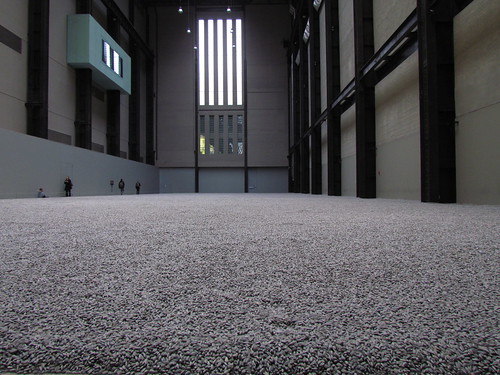Ai Weiwei
Tate Modern
12.10.10-2.5.11
http://www.tate.org.uk/modern/exhibitions/unileverseries2010/default.shtm
http://aiweiwei.tate.org.uk/content/most-asked-questions
100 000 000 handcrafted ceramic sunflower seeds cover the floor of the massive Turbine Hall of Tate Modern. This is the installation "Sunflower Seeds" by Chinese artist Ai Weiwei. This was something I just had to experience.

First of all the symbolics connected to sunflower seeds in China. In the cultural revolution Mao was considered the sun, and his people the sunflowers. Through hard times with almost nothing to eat, they would always have some sunflower seeds as snack. And as a social mediator, sunflower seeds were presented when you had nothing else to offer your guests. Sunflower seeds do not need any special conservation, and give a decent harvest when planted.
And then about the material and the process. All seeds were made in the town of Jingdezhen, famous for the fine quality ceramics for the imperial court. The procedures are the same now as centuries ago. All is done by hand, from the extracting of stone from the quarry, until the hand painting. About 1600 people were involved in making these seeds, and this lasted for 2,5 years. There is a background video and a cataloge showing the production process.

In the beginning the viewers could walk around on the seeds in the Turbine Hall. But as friction created unhealthy dust, it was stopped. It must also have played a part that probably many visitors slipped a seed or two in their pockets.
I think the aspect that walking on the seeds were first allowed, now forbidden, is very interesting. Not often is an art piece put behind fences to protect the public, not to protect the art. I also think about what it does to the installation knowing that some of the seed were slipped into private pockets. Does it diminish the installation? If not, where would the limit be? In fact, during a performance, some real sunflower seeds were shot into the mass. No one will ever find those again.

the artist in a scene from the background movie
Is it a collection of many individual sculptures, one large installation, an interaction with the viewers, community art or political art? It is all of this at the same time. Each unit is hand crafted, unique like an individual person. It just blows my mind thinking about that if each seed should represent one Chinese, the amount should be 13 times larger! But this is also a whole installation, represented as a carped of units. The interaction with the viewers are no longer by threading on it. But you can communicate with the artist through interactive screens next to the installation. This is also a kind of community art in the sense that it engages a whole community, where the ceramic-making traditions are held up high. At the same time, I can not imagine how the workers consider the meaningfullness of making something "totally useless". It can also be seen as an political art piece, that point against conformity.
Have a look at my view on the smaller but wider Ai Weiwei exhibition at Faurschou gallery in Copenhagen